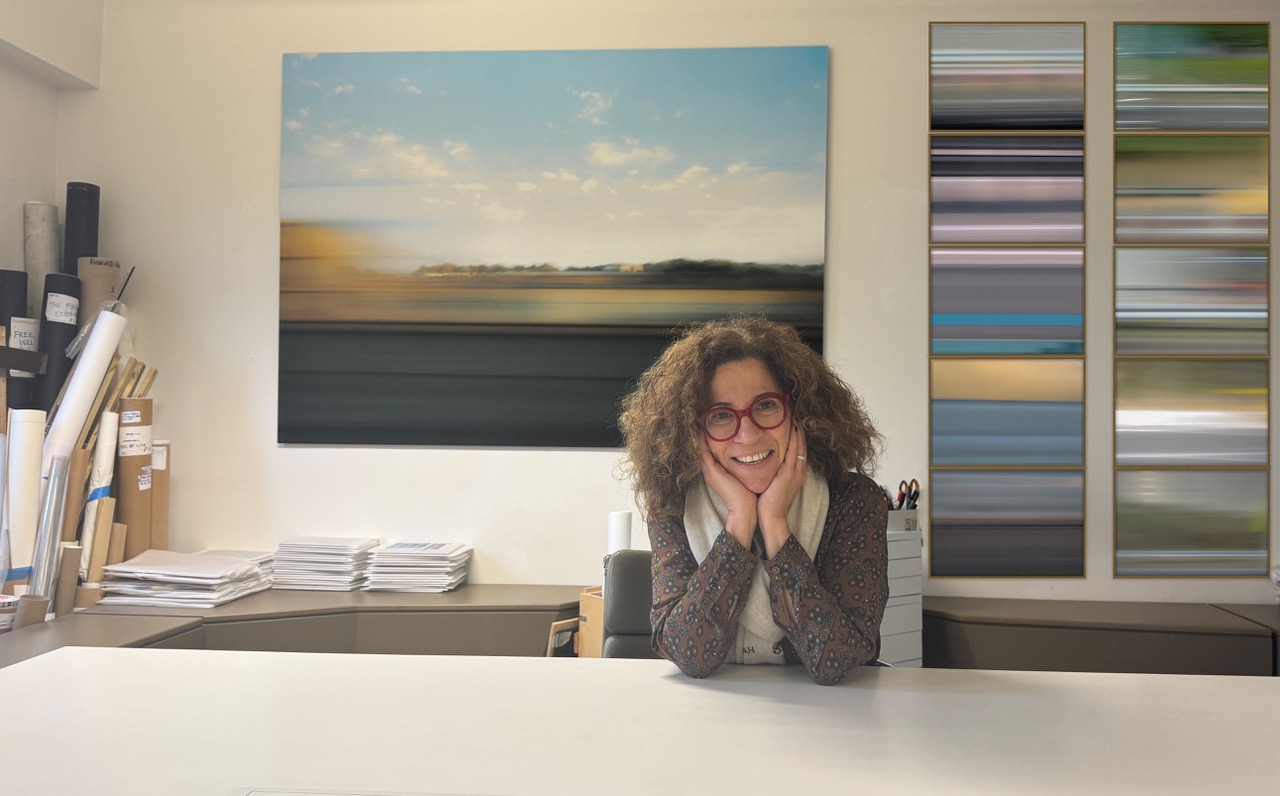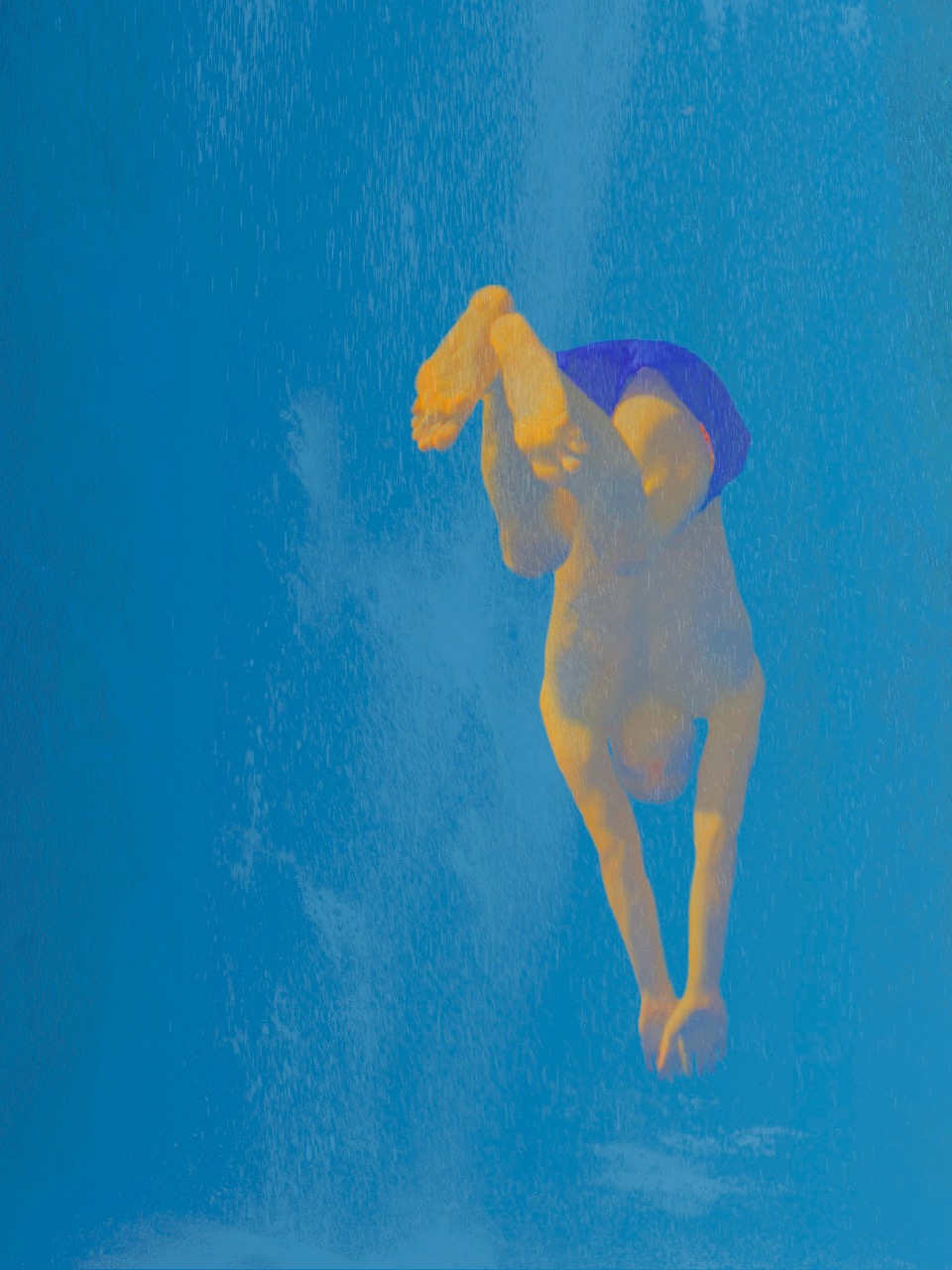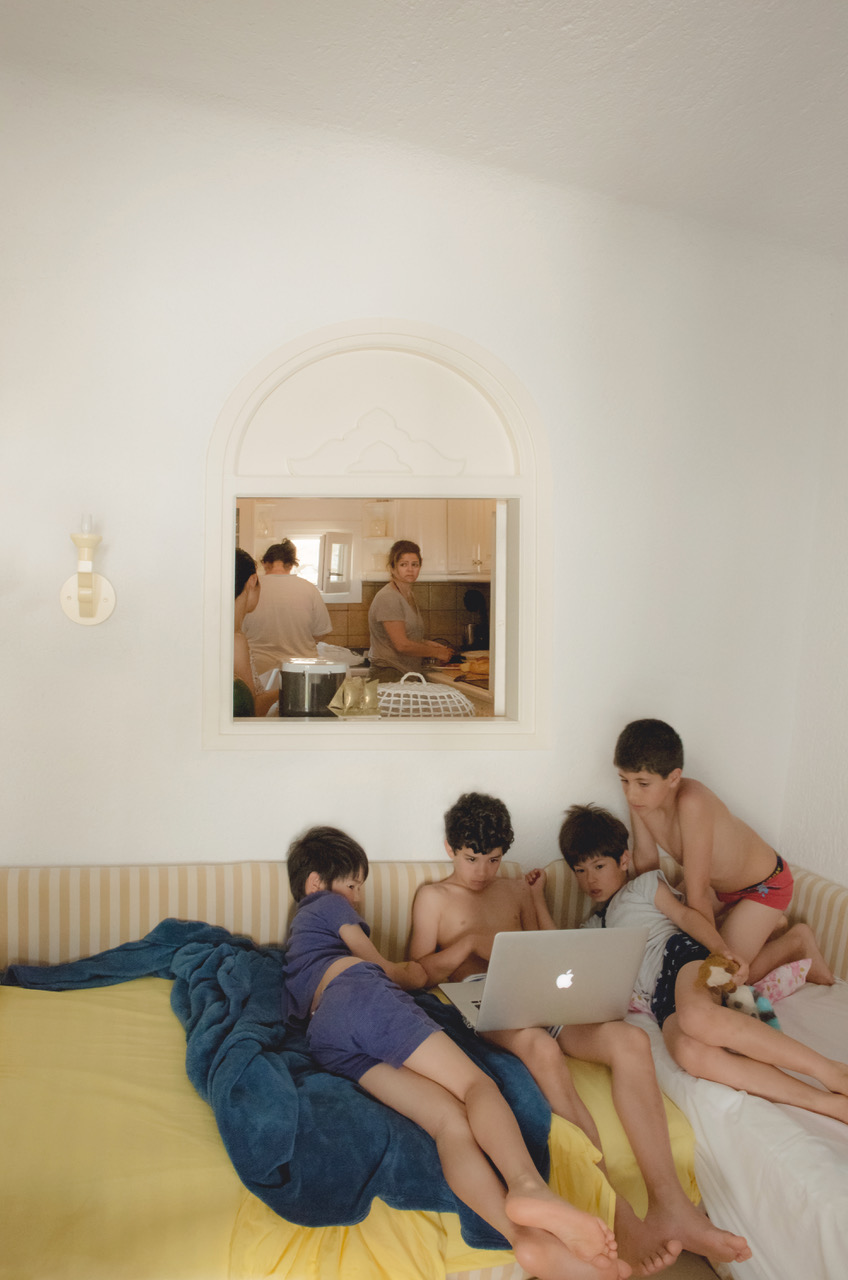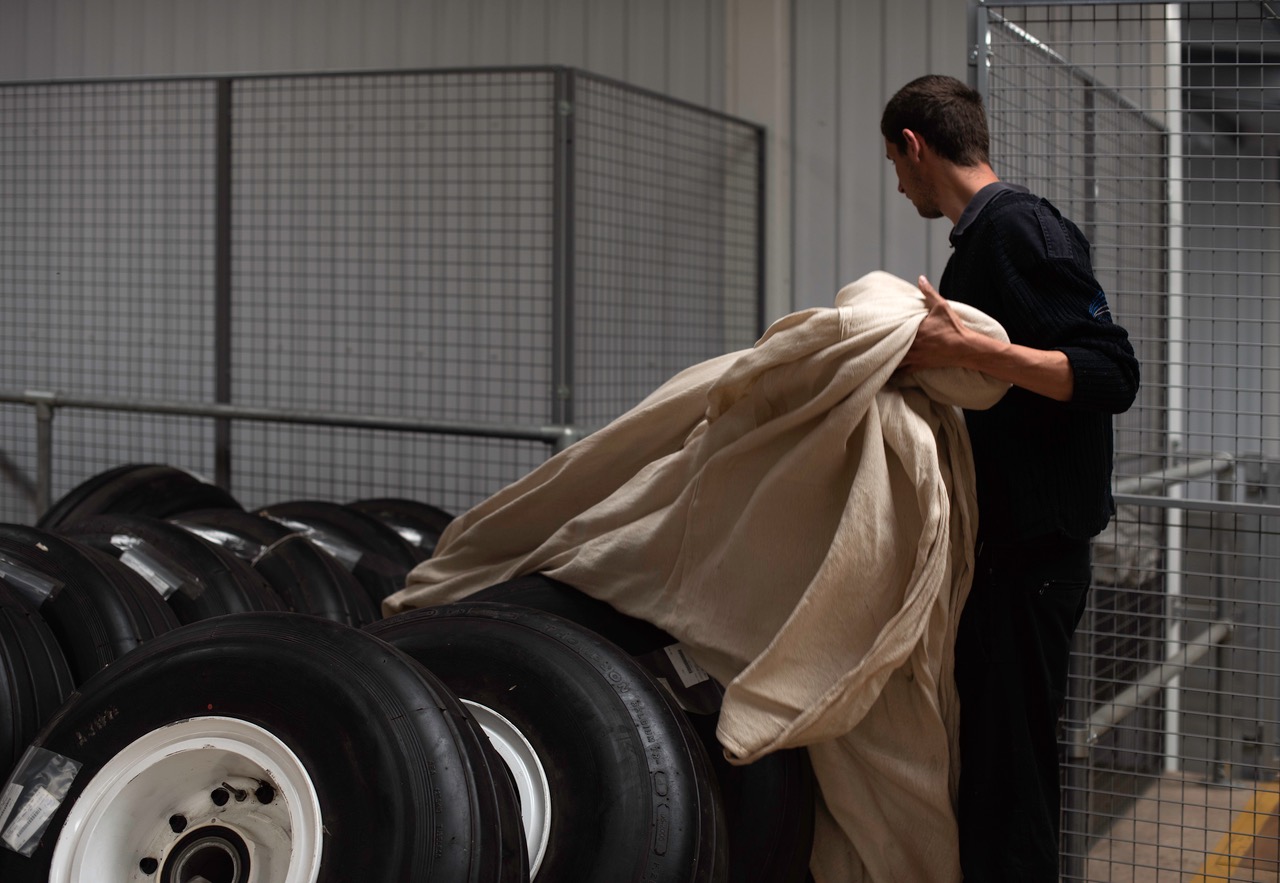Of memories, movement and multi-media explorations
Rooted in photography yet always pushing beyond its boundaries, Hania Farrell’s practice reveals a rich tapestry of influences — including a few she’s only recently come to recognise herself. In this wide-ranging conversation, the Lebanese-born, London-based artist tells Artscoops how the science of space sits at the core of her process, layered with emotion as she searches for threads of humanity in a world so often marked by division.

Hania in her studio with her new work from the series Mental Hues, 2025
You studied subjects that included Applied Science and Interior Design in institutions located across several global cities. How did that journey lead you to photography?
My studies have all contributed in their own way to my career. Applied Science gave me the understanding of structure and systems while interior design sharpened my sense of space. Space is central in my work, not just from a compositional angle but from an emotional one too. You can see and feel that in works like ‘Helix’ or ‘Anatomy of flight’.
I became interested in photography long before university, when I was given my grandad’s camera, aged 14, after he passed away. I began taking photos soon after and developing them in my bathroom. I loved the process, it had a quiet authenticity that felt magical when an image appeared. Decades later, someone approached me at a concert to tell me that I’d taken their photo as a child and that the portrait was still hanging in their living room. It was then that I realised how powerful photography can be.

Diver 17 © Hania Farrell, 2021
Photography has at times been given less weight than other fields in visual arts. Do you think it has now achieved its rightful place in the industry?
Admittedly, in years gone by, photography was mostly associated with documentary reporting. But today, it finally stands shoulder to shoulder with other conceptual art forms, such as sculpture and painting, and continues to evolve as a language. Artists such as Wolfgang Tillmans, Hiroshi Sugimoto and Cindy Sherman have shown that photography can be intellectual, but also emotional, intimate and abstract.
I realised early on that I wanted to expand the medium in my work and push beyond the still image. I think this is why I began experimenting and playing with other ideas, such as reflections, video, installation and animation, for example. These areas of exploration have felt like natural paths to take. But they also help to show that photography is a really transformative medium.

Minecrafting © Hania Farrell, 2016
Is the direction you’ve taken in your practice of creating immersive, multimedia environments a deliberate evolution or something more intuitive?
It’s definitely intuitive, although a lot of the time, the process begins with a photo. As momentum builds, I find myself wanting to expand the project further and it gradually takes the shape of an installation. I’ve found over time that this is also a natural way to bring people into the experience, allowing them to glimpse what I saw when capturing the moment. The ‘Playful Reflection’ diving series is one such example. Watching the divers repeatedly leap into the water was mesmerising. I knew that the only way to share their experience and my own reaction was to animate the photos. In that way, viewers would get as close as possible to the moment - the rise and falls, mid-flight antics and the broader carefreeness of youth - everything I witnessed and felt. This is what pushes me to expand my work.
Identity, belief systems and cultural stereotypes are central to your work. How does straddling two worlds - Lebanese heritage and life in London - inform how you explore these themes?
Both Lebanon and the UK have informed my practice in vital ways. Lebanon is a major part of my heritage and close family members still live there. Alongside my childhood memories, it has also given me qualities like resilience, which are inbuilt in the Lebanese people. And then there is the sense of freedom I have gained from living in the UK and the alternative perspective you inevitably get when you move countries. The two cultures overlap and I often find myself navigating between the two when exploring topical issues. As a result, sometimes I find myself searching for a thread of humanity when emotions are running high, trying to seek out what connects us - commonality - rather than what sets us apart. In ‘Teal’, my first exhibition, for example, I chose water as the overarching theme. My aim was to combine the personal with the universal and explore something that resonates with all of us in one way or another.

Installation N33°_54’ E35° 28’ from TEAL - © Hania Farrell, 2013
Your subjects are intriguingly diverse. Where do you find your inspiration?
I find inspiration in many different places on a daily basis, in chaotic encounters and, just as often, in stillness, late at night, when ideas arrive fully formed. Each spark triggers new thoughts and ways to develop them. Over time, I’ve realised that I’m often inspired by movement, and as a result, the thread in my work explores motion both literally and abstractly - through moving subjects and shifting perceptions.
This fascination with movement likely traces back to my own life. As a child, I moved countries many times, and my memories are filled with airports. I used to go with my grandad to watch planes take off and land, mesmerised by their grace. Only recently did I realise that travel and aviation runs deep in my family. Not only my father, brother and sister, but also relatives who emigrated to Ecuador and to the US - all connected, along with their children - to this field in one way or another. Years later, I found myself photographing airplane parts, as if that thread had quietly resurfaced. Our experiences - even the ones we believe forgotten - live on within us. I’m a firm believer in cellular memory, the concept that our cells can retain and respond to information about past stimuli.
You have been awarded several prizes and shown your work extensively. What do you regard as your career highlights to date?
Showing my work twice at the National Portrait Gallery for Taylor Wessing Photographic Prize certainly brought very special pinch-me moments. Receiving the Chatham Dockyard Prize for Helix [a series of works about a family-run shipping business] and the ArtGemini Prize for Minecrafting in 2016 also made me really proud. Both works explore themes that still guide me in my work today. Other highlights include the time I was invited to exhibit The Tondo light-boxes inside the Mdina cathedral museum in Malta as part of a biennale in 2017-2018. But balanced with these major occasions are the times when I see or hear about someone connecting deeply with my work. Those flashes of recognition can come out of the blue which heightens their impact and makes them just as special in their own way.

Anatomy of a Flight #3 © Hania Farrell, 2016
What are you currently working on?
I’m currently working on ‘Mental Hues’, an expanding series of abstract photographs that were initially captured in transit in Japan. In this series, each hue is a window of the mind, carrying its own emotional weight and exploring liminal spaces where change happens.
My inspiration for this series comes from the Japanese philosophy of ‘ma’ - the essential void within all things that gives meaning to what surrounds it. It’s the pauses in music or speech that bring emphasis, or, for example, the quiet moment in busy times or the negative space in architecture that defines form. This philosophy dovetails with my fascination with space which is central to my work as I explained. In ‘Minecrafting’, for example, there’s space and different-sized windows in the composition, which accentuates both the distance and connections between the people in the photograph.
I think my latest work is moving in a more poetic and painterly direction which is pleasing. I’m enjoying seeing that effect from a camera.